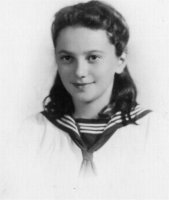
Jolanta Zawadzka-Kolczynska née Zawadzka
born November 16, 1928 in Warsaw
Home Army soldier, messenger, pseudonym "Klara"
6th company of "Jeremi"
Home Army group "Chrobry II"
The Witnesses' Uprising Reports
Memories of Jolanta Kolczynska "Klara" - a messenger of the "Chrobry II" army group
 |
|
I was born on November 16, 1928 in Warsaw into a typical intellectual family. My father Stanislaw was an economy professor and my mother Gabriela - a painter and a pedagogue. My uncles occupied responsible positions. One of them was the director of the Institute for Deaf-mute and Blind People, while the other was the curator of the Warsaw School District Board of Education.
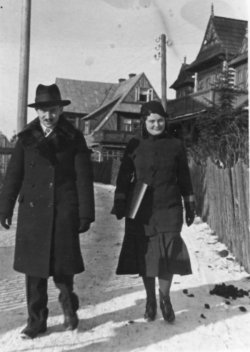
Stanislaw and Gabriela Zawadzki, Zakopane 1938
Before World War II we lived in beautiful multi-room apartments, first on Grojecka Street and later on Filtrowa Street in Ochota district. I attended a private school named after Wanda Szachtmajerowa née Posselt. The school was founded in 1908 by five sisters and was initially located in an old rented building on Chmielna Street. In 1930 Marshal Jozef Pilsudski personally laid the cornerstone under the new seat of the school at the corner of Radomska and Bialobrzeska Streets. Within two years a new modern school was erected on this site. Even during the years of the People's Republic of Poland this institution still surpassed a nearby school of millennium in terms of functionality. The school provided education from the level of a mainstream school to the high school final examinations "matura". After the new building was erected, the organization of the school somewhat changed. The six-grade mainstream school remained a private one while four grades of the gymnasium and two grades of the high school were transformed into the Foundation of Wanda Szachtmajerowa née Posselt.
The school pupils (it was a school for girls) prided themselves on being the only ones in Poland to wear green school uniforms.
One of the floors in the Jablkowski brothers' department store located on Bracka Street was the place where the uniforms of our school were sold. The winter uniforms were made of wool, while the summer ones were silken. Additionally, there were ceremonial white blouses with long sleeves. In winter, the pupils also wore green overcoats with grey astrakhan fur collar. We put on those elegant ceremonial dresses even when we attended our First Communion.
In addition, we had at our disposal green overcoats and berets made of six pieces of fabric sewn together like a tangerine, wearing a mark - a clover embroidered with a silver thread.
The school gathered the elite of Warsaw girls. The pupils included among others the daughters of Jozef Pilsudski, the Branicki sisters from Wilanow, daughters of landholders, bank directors, factory-owners. Being so elitist, the school was also very democratic. This was one of the reasons for which the headmistress introduced homogenous school uniforms. Furs and expensive clothes were not to be worn on the school premises.The school uniforms were mandatory in our institution.
At the time of the outbreak of World War II I had already finished my 4th grade of elementary school.Soon the Germans took over the school building. As a result of pleadings and exertions of our headmistress, they agreed to give us only two exhibitions halls, situated one above the other: a geographical and environmental class and a physics class. They were located in the corner of the building with a separate entrance. The classes were conducted in these rooms and included also prohibited school subjects, such as history, geography and the English language. The classes were also carried out outside the school premises as part of the underground education, especially on a gymnasium level.
The secret education was organized in private apartments. The majority of my friends lived in large apartments, so part of the classes took place in those rooms. An additional advantage of these apartments was the fact that they were equipped with two entrances. If the Germans would like to enter the apartment using a door from a frontal staircase, there was the emergency exit through a kitchen door on the other side of the apartment. The secret courses could not be organized in my apartment for reasons I will soon explain.
The education in the occupational school lasted until the outbreak of the Warsaw Uprising in 1944. Within this period of time 135 "matura" final examinations were conducted and then verified soon after the end of the war. All girls who passed their conspiratorial "matura" examinations later obtained standard national "matura" certificates. The school was also home for the activity operating underground 16th Warsaw Scout Troop.
On May 10, 1940 the Gestapo police arrested my father for the organization of the May 3rd National Holiday in education. He was first kept in the Pawiak prison and later deported to Auschwitz and Buchenwald concentration camps. He spent altogether five and a half year as a prisoner at different concentration camps, living in extremely harsh conditions. He organized a resistance movement in Auschwitz. He survived only thanks to his strong organism and stamina. He also underwent a lung operation in the camp conditions. The operation was conducted with the use of a kitchen knife by a prison mate, professor Rudolf Diem, who after the war worked in a railway hospital for many years. My father, at that time thirty odd years old, survived the operation carried out in extremely difficult conditions only thanks to his tough organism. After the operation performed at night, my father, supported by his inmates, attended the morning assembly as usual. He could not fall down; otherwise he would have ended his life on a heap of corpses.
The first transports of the prisoners to Auschwitz started in 1940. On June 14, 1940 a transport from Tarnow headed for Auschwitz. It consisted of many young boys who tried to escape to Hungary but were caught by the Germans. Mostly, they were high school students. They were kept in the camp together with common criminals and rascals. They were all transported to Auschwitz.The Auschwitz concentration camp was built for the Poles and initially, for the first two years, its prisoners were only of Polish nationality. As late as in 1942 and 1943 first transports of Jews from different countries, such as Belgium, France etc., began to arrive at the camp. For the first two years only political prisoners and criminals were deported to the camp. Later, besides Jews, there arrived Poles arrested as a result of round-ups.
When my father was taken into custody, my mother and I were expelled from our apartment at 73 Filtrowa Street on the corner of Raszynska Street. It was next occupied by a family of volksdeutsche. The apartment accommodated many antique pieces of furniture, for example those coming from the Royal Castle. Professor Lorentz, my father's friend, saved them from the burning Castle in 1939 and placed them on deposit in our apartment. The impressive royal furniture adorned our gigantic living room. All of it was taken by the volksdeutsche. We were turned into the street just as we were, with a suitcase in the hand.
For some time we wandered through the city streets. In 1942, after the liquidation of the so called large ghetto, the occupational Polish Teachers' Union was able to take over two post-Jewish houses facing each other at 5 and 6 Panska Street. These houses were now occupied by teacher families thrown out from their apartments in different Warsaw districts. My mother and I were accommodated in a small apartment at 6 Panska Street, where we lived until the outbreak of the Uprising.
In 1942, at the age of 14, I became involved in the underground movement. By that time, my older cousins had already joined the underground forces. My mother was also active in the conspiracy. My task was to transport weaponry. I was a small, inconspicuous girl. My additional advantage was a good command of the German language. Before the war I had had a nanny called Greta, a trueborn German woman.
Together with my friend we transported weaponry from Warsaw to Kozienicka Forest, where the insurgent troops were stationed. As a means of transport we used… a ship plying along the Vistula river from Warsaw to Pultusk, Pulawy and even further on. An underground depot was located in the cellar of one of the residential houses somewhere on Wolska Street. Each of us would pick up 2 packages there, each for one hand. We would then embark on the ship that plied at night - usually in the summer. We would sit on crates on the upper deck, among groups of people, mostly merchants. As each one of them also carried various packages, we did not capture anybody's attention.
The ship sailed to the town of Ryczywol near Swierze Gorne in the Kozienicki Forest (at present there is a power station there).A local married couple strongly involved in the underground movement helped us in our smuggling activity. On site there were horses waiting for us: blindfolded, we were taken to the forest to meet the partisans. These operations took place mainly in 1942-1944.
On August 1, 1944, after the outbreak of the Uprising, my friend and I reported to the nearest insurgents' gathering point commanded by Second Lt. "Jeremi", commander of the company in the Home Army battalion "Chrobry II". The outbreak of the Uprising took the residents of Warsaw completely by surprise. When the fights began, trams and autobuses riding through the city streets were full of passengers. But when the shootings started, the terrified people tried to find cover at the gates or ran away in panic. Shots could be heard in many districts. In Zoliborz, the fights began two hours earlier.
My friend and I were sworn in by Second Lt. "Jeremi", commander of the 6th company in "Chrobry II".I chose the pseudonym of "Klara". Throughout the whole Uprising we were the messengers of our commander. The Home Army group "Chrobry II" was formed after the outbreak of the Warsaw Uprising. Initially, it was named "Chrobry". After three days, however, the group commanders learned on Twarda Street that an army group bearing the same name had already been formed during the occupation. This was a specific feature of the underground movement. In this situation, the newly-formed group accepted the codename of "Chrobry II", while the already existing one - "Chrobry I". At first, "Chrobry I" was involved in the fights in Wola, then in the Simons Passage in the Old Town where it suffered heavy losses, and finally in Srodmiescie.
Our first outpost was located in a large edifice at 23 Wielka Street, facing Panska Street. Our headquarters was situated in the backyard of this building. Later we moved to the Jarnuszkiewicz factory at 25 Grzybowska Street. It was a large factory manufacturing metal beds and medical equipment - a few big edifices and two backyards. Today, the "Mercure" hotel stands in this place. Our task was to reinforce a unit that could not hold much longer on its own. The Germans were stationed on the other side of the street.
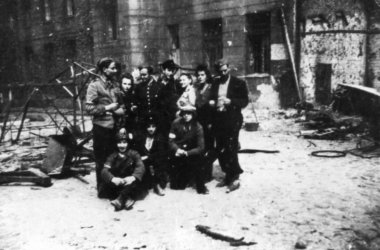
Soldiers of Jeremi's company in the backyard of the Jarnuszkiewicz factory.
Third from the left - Lt. Jeremi, third from the right - J. Kolczynska.
The company led offensive and defensive actions to protect Srodmiescie against the Germans. The German positions were situated very close to us: we could hear their conversations and commands. One day, as a result of, as it turned out later, a false alarm my commander ordered me to go to Srodmiescie to bring back reinforcements. I was wading through the street burning on its both sides. Somehow I managed to get to and fro, and when I returned it turned out I had risked my life to no avail as the alarm was false. The commander apologized profusely and was really happy to see me safe and sound.
The situation was unclear. We did not know how great the enemy forces were.The Germans took over Mirowskie Halls and a great massacre took place there. In the halls, the Germans executed men, women and children. Then they began to approach Grzybowska Street. We attempted to take over a house on the even side of the street, at 16 Grzybowska Street. There were two backyards there. We got across the first backyard without any problems, it was very quiet. Then we entered the second backyard - the same situation. A moment later it turned out that the Germans hid in the apartments behind the windows facing the backyard. When we reached the middle of the backyard, they opened fire. We had to retreat.
Only the commander of the partisan group from "Ponury" from the Swietokrzyskie Mountains was left behind. The partisans from this group had broken through to Warsaw and took part in the Uprising. Bronek Sianoszek, commander of the "Baska" section, did not retreat with us. After the unsuccessful action we checked the status of the unit and discovered his absence. Nobody knew if he had been injured or killed. We suspected that he had been shot and was lying somewhere in the rubble. After the war it turned out he was quite lucky. He came from Ukraine and knew the Ukrainian language. The Germans who had caught him had some Ukrainians in their ranks. Bronek started talking with them in their mother tongue and was not executed on site. He was taken with them as a hostage. Luckily, he survived the war.
"Chrobry II" operated on a large territory of Warsaw. It extended along Marszalkowska, Krolewska, Grzybowska and Towarowa Streets and reached Aleje Jerozolimskie. In total six companies participated in the fights. Only one unit, the "Gurt" group, defended the bridgehead in the former railway station situated at the corner of Chmielna and Marszalkowska Streets and Aleje Jerozolimskie. There were also other garrisoned outposts on Towarowa Street, where I often delivered reports. Our headquarters were located on Zelazna Street. Also on Zelazna Street, but closer to Aleje, there stationed the "Warszawianka" unit of the National Armed Forces. Later this unit joined our group as the 2nd company. At the beginning of the Uprising, the soldiers from the National Armed Forces captured the building of the Warsaw Stock Exchange on Aleje Jerozolimskie. The building stood opposite a new railway station that was later destroyed. Unfortunately, they were not able to hold the building for long and had to retreat to Zelazna Street.
Opposite "Warszawianka", on the other side of Zelazna Street, there was a post train station, still in a raw state and not yet rendered for use. The building was large and beautiful, accommodating various cellars and passages. It was garrisoned by the 3rd company of "Zdunin". "Chrobry II" occupied also other strategically useful buildings.
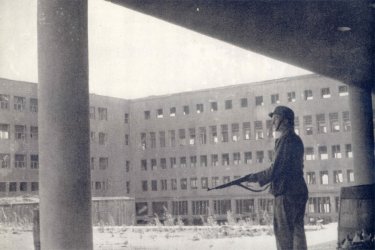
Post train station taken over by the insurgents
The majority of the insurgents in "Chrobry II" were young boys. Our commanders, older than us, were trained to fight in the city. They could direct the fight so that the casualties were minimal. Each undertaken action was first analyzed in this respect.
Our company participated in a few interesting actions. In the first days of the Uprising we took part in the mission of capturing the barracks of the Navy-Blue Police on Ciepla Street. We found and secured some police uniforms in the captured buildings, which allowed us to standardize our own clothes. So far, each of us had been using their own personal clothes. Our girls were given large navy-blue blouses, which looked like coats on our petite bodies. The boys dressed themselves very seriously - we started looking like a regular army. Some insurgents in Wola wore German camouflage dresses obtained from German soldiers. Some of them even had German helmets with red and white bands put around them.
Our company contributed to the capturing of the Pasta building (belonging to the Polish Telephone Joint-stock Company).After two days of struggle over Pasta, the "Kilinski" group suffered heavy losses. Finally, a messenger came to our commander, asking him for help. The commander approved and our soldiers could join the battle. This was the first time when I saw a dead man at close range. My best friend, a 16-year-old boy, died there literally at my side. We were climbing the spiral stairs up the Pasta building.The Germans were hiding at the very top of the stairs. Suddenly, they opened fire. My friend was practically cut in two with a burst from a submachine gun. First time in my life I saw a dead man I had been talking to just a moment before. It was a traumatic experience. Even today I can recall his massacred body. For many years after the war we were holding a grudge against the "Kilinski". When they placed a commemorative plaque on Pasta, they "forgot" to mention our unit. The plaque only contains an evasive statement "… and other units". Many of our friends lost their lives in this battle.
At the end of August our task was to break through the Saxon Garden towards the Old Town. This was to be a joint action of the Old Town and Srodmiescie troops organized by Col. "Wachnowski". Unfortunately, the organization of the mission failed. The hours of commencing the attack were mixed up. The Old Town units began the action two hours too early. Almost all of the attackers were killed off by the Germans. Two hours later we launched an attack and ended up as the previous unit. This event took place on August 31, 1944.
At the end of September a messenger reported to our commander in the Jarnuszkiewicz factory and informed him about Sten guns which had been buried deep in the basements on the premises of our factory, manufactured in an underground arms factory. The factory operated on the territory of the then existing ghetto. However, none of the weapon manufacturers had arrived at the factory when the Uprising had broken out. It was a pity since this weapon would now come in handy. We learned about this finding around September 20, soon before leaving the outpost.
Scarce amounts of weapons were partially supplemented by air drops. Unfortunately, the containers were parachuted by the Allies from a great height and very often they found their way into the German hands instead of ours. The Russians flew the Polikarpov Po-2 planes at low heights, usually at night. They dropped weaponry and food in containers without parachutes, instead lowering it on special ropes. As a consequence, on opening the container that had fallen on the paving it often turned out that the weapon was seriously damaged and sometimes even food was unfit for consumption.
Within the operating area of the army group there were a few gunsmith shops. The specialists who worked at those factories made wonders, repairing damaged weapon - both dropped and captured. There were also grenade factories, with which we tried to replenish our weapon stocks. The grenades were manufactured in bags or tin cans. A well-known gunsmith shop located on our territory was on Sienna Street. In spite of the scarcity of weaponry we held the area assigned to us for 63 days. We, the messengers, were not allowed to carry a weapon. We could only take grenades with us.
The messengers who carried the orders could not use any pieces of paper. The message had to be memorized like a poem. The crossing to the other side of Aleje Jerozolimskie was a very difficult and dangerous task. The Warsaw cross-city line ran approximately half a meter below the surface of the earth under the current tram line. A concrete ceiling separated the tunnel from the surface. There was no way of digging up a trench. Only on Krucza Street there was a half a meter shallow ditch leading across Aleje. The military police guided the crossing, letting out the pedestrians in turns. There was a constant machine gun fire directed from the National Economy Bank and Polonia Hotel. The military police officers would count the breaks between the shootings. When there was an appropriate pause between the first and the second burst of fire, they would let out a few persons.
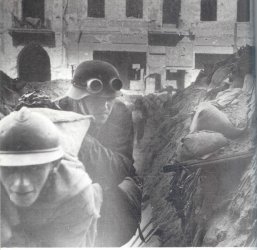
The crossing through Aleje Jerozolimskie
We arrived with our orders at Krucza Street. We were to deliver the message to Gen. Bor Komorowski, whose headquarters was located at that time on Mokotowska Street near the Three Crosses Square. There, in the backyard, stood a medium-sized three-storey building (it stands there even at present).On our way to our destination we were rained with shrapnels and dirt from the explosion of a German mortar shell (by Varsovians called a "cow"), which hit Krucza Street nearby us. We were all very dirty, covered with dust. I remember the soldiers telling us: "Go wash yourself before the commander can see you. We can't let you in such a state. "We did as they told us and reported to the General. We gave him the message. Gen. Bor Komorowski was very willing to learn how the situation on the first line looked like and what was happening in our unit. He was very nice to us.
Then we had to go back to our troops. On our way back, at the corner of Swietokrzyska Street, I was injured in my leg with a dum-dum bullet. It was an expanding bullet, which left in my knee lots of tiny shrapnels. I went to a first-aid field station where the medics cleaned the wound a bit. I was not injured seriously enough to be referred to a hospital, so till the very end of the Uprising I was on service.
During the Uprising "Chrobry II" numbered approximately 3500 soldiers. Apart from privates, the company also included military police, the Female Aid to Soldiers Organization (PZ) and other services. My company was made up of around 200 persons. Later we managed to recreate the list of all its members. However, some names were not possible to be determined. When young volunteers reported to the commander, they had to take the oath. We were able to determine the composition of the company numbering 201 people.
We had a wonderful commanding officer. Just like my father, he was thirty-odd years old and just like him he was very protective.
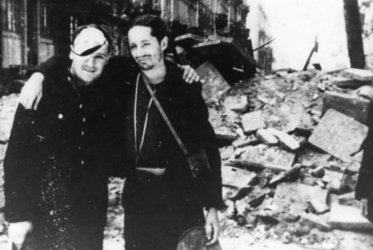
Lt. "Prawdzic" (injured in his head) and an unknown insurgent
Thanks to his commanding abilities, many of us survived the Uprising - in total more than 2/3 of our group. Several of the soldiers died later after the Uprising, in camps, suffering from sustained wounds and exhaustion. Our extraordinary commander made sure that all the actions were prepared in such a way that there would be no more than a few wounded soldiers. Most of the casualties constituted the nurses. They were the first to come with aid and to reach the wounded person in action. Very often they would get caught in fire in which both they and the wounded soldier were killed. Most of the messengers survived the war.
Sometimes we were visited by our commanders. One day Gen. "Monter" dropped by to our outpost. He used to turn up suddenly and without warning. He would see the outpost and ask the soldiers how they were doing, how their sleep was, how they felt. He would also ask about the commanding officers. Our command on the other hand organized briefings with company commanders and other officers to discuss the situation and any other issues concerning the fights. I am of the opinion that our commanders were well-prepared and tried to ensure that we completed the tasks committed to us the best we could.
It should be remembered that our group consisted of many volunteers. Many of them were young boys. During the occupation they tried to help their families in different ways, sometimes being their only breadwinners. One of the ways to procure food was to steal it from German train carriages.
On the railway side-tracks there were many carriages containing food for the German army which was sent further to the Eastern front. At nights, the boys would open the coaches and steal the food away, which was later sold or given to their families. This task was a very dangerous one, as nights were short and the railway German patrols would shoot the thieves without warning. I remember that one time a train car full of Greek turtles was robbed. Later, all Warsaw fed on a turtle soup. Those who have seen "Café pod Minoga" movie perhaps remember turtles being traded in at market places.
Those brave boys later reinforced the insurgent ranks. They were not afraid at all, probably not realizing the extent of the danger they were facing. I remember one small boy, a.k.a. "Pestka" ("Pit"), who was nine years old. One day he came to our commander and declared he would be a soldier. His older brothers had already joined the insurgents and he would not stay at home too.
The commander had a long discussion with him. "Pestka" was a tall, slender boy, very agile. After some time the commander was visited by the boy's mother. She said that all her sons had left her, Pestka was the youngest one, and she begged the commander to send the boy back home. "Pestka" claimed that he had already taken the oath, he was a soldier now and had no intention of returning home.
At that time the Russians air-dropped some supplies on Grzybowski Square. The ropes of the container tangled up in the bushes growing on the square and the container could not be moved. "Pestka" said that he would steal up to these bushes, untangle the ropes and drag the container along with him, as he felt certain there must be food inside of it. The commander gave him a strict order not to even try as the Germans kept the square under close observation. If they had noticed some movement, they would have surely opened fire. The boy said that he would be alright. The commander only repeated his order.
But you know youth. "Pestka" waited until dusk and then crawled up to the bushes. He started pulling the ropes, the bushes swayed and the Germans, as you can easily imagine, blasted away their machine guns. The boy was shot in his butt. He stood up and exclaimed: "Those rascals! Sir, look what they have done to me! "The commander shouted: "Hit the ground or they will kill you!"
We pulled him by his legs to a safer position. But he would not let go of the ropes. Finally, the container was ours. Unfortunately, we only found groats and some crackers inside of it. The weapon, as usual, was destroyed. Very rarely did we manage to repair any of the Soviet weaponry in our gunsmith shops.
One day during the Uprising "Pestka" approached me and stated: "You are a bit older than me, so I won't call you by your first name, but I can call you AUNTIE. You want that?" I said it is okay.
"Pestka" survived the war. He finished a sea school and worked as a seaman sailing on trade ships. Some years ago one of my friend messengers was visiting the sea coast. She wore elegant clothes as she walked up the street. Suddenly she noticed she had been being followed by some sailor. She tried to lose him but he still stubbornly followed her steps. Then she heard a voice coming from behind: "Auntie, it's me, "Pestka"".
In our headquarters on Wielka Street we set up a field kitchen. We cooked groats, also called groats-spit, in a large cauldron and distributed it to the other outposts. It was also delivered to our outpost on Grzybowska Street. The groats came from the Haberbusch's brewery. The boys had lugged it in bags on their backs to our headquarters at the beginning of the Uprising so that we had something to eat.
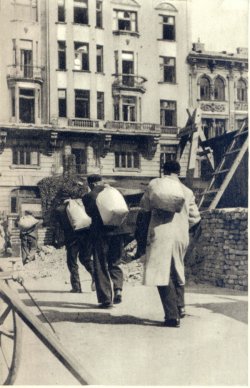
Transport of grain from the Haberbusch's brewery
Of course we could not make any fire at our outpost because the Germans would immediately spot our position. We kept as quiet as it was possible. The sentries on duty kept watch all the time and checked whether the Germans were not stealthily planning any maneuvres. There was a large gate at the Jarnuszkiewicz factory. The gate was guarded by the sentries who constantly listened out for what was going on the other side of the street.
The factory was equipped with the pumps. Thanks to them we could draw up water and wash ourselves. Between the shifts one could take a nap on the straw placed in the ground-floor quarters. Of course our soldiers always slept fully dressed so that they were continually ready for action.
In Srodmiescie we could find coal for fire. We used this coal to heat cauldrons with food. We also collected briquettes and timber from destroyed houses. We had an abundance of this kind of material in the vicinity of our outpost. Window shutters, frames, armchairs etc. - all this was reduced to rubble. Panska Street lay in ruin. The house where I lived was situated opposite another building which was destroyed by a mortar shell. Many people died as a result of the explosion.
As I mentioned before, our group was made mainly of volunteers. The group was very diverse, though in majority it included very young people. We had no ethnic or religious issues. All people were treated equally by the commanders and fellows. Our commander used to say that we all were his only children. There were a few Jews in our ranks who came from a group liberated at the beginning of August in Gesiowka. They fought arm in arm with us to the very end. Those who became prisoners of war were protected in the camps by other colleagues.
A few years ago Gazeta Wyborcza (a daily newspaper) published an article which said that during the Uprising in our area of activity the insurgents killed the Jews. The truth is a bit different. On one of the streets there was a building with a wall facing the former ghetto territory. There lived a Jew who would often visit our outposts. He would treat our boys to sweets and ask how many of us there were, what kind of weapon we possessed, what we were planning to do. He was a tailor by profession. In his house he had a room with a large wardrobe full of clothes. As it turned out later, the wardrobe was equipped with a rear hatch which could be opened. It was a secret passage that the tailor used to pass through the hole punched in the wall and reach the area occupied by the Germans. He would pass the information he had obtained from our naive boys to the enemy. As a result of his denunciation a few of our soldiers lost their lives.
When his true activity was revealed, the spy was judged by a field court martial and sentenced to death. The sentence was executed. It was not the killing of a man of Jewish nationality, but the liquidation of a dangerous German informer. I do not know what pushed this Jew to do what he did. What was he counting on? He must have already known how the Germans behaved towards the Jews.
Towards the end of the Uprising we evacuated all civilians from our territory. There were mothers with children, sometimes old people, who lived in cellars. They did not have water or the possibility to cook food. They could not survive living in such conditions, although the cellars were relatively safe places.
Initially, the civil population was very enthusiastic towards the insurgents, ready to help them as they could. However, as the fights got drawn out, their attitude began to change. The tormented civilians did not have anything to eat, no place to sleep. They were becoming more and more ill-disposed and eventually even hostile towards us. They started cursing the soldiers: "Now look what you have done! What has become of all of this! "We felt uneasy, after all we were not guilty - we fought for the liberation of the city.
A Warsaw citizen, who during the Uprising was just a small girl, recalls:
During the Uprising I was a 9-year-old child living on Grzybowska Street at the corner of Wronia Street. There was a barricade there and a heavy shooting. We lived on the left side of Grzybowska Street, literally at the corner of Wronia Street, in a large house. Today there is no trace left of it; there is probably some square built on its place. The barricade stood across the street. The civil population gathered in shelters situated in the warehouses of the Haberbusch's brewery. The brewery warehouses and large buildings were located on the right side of Grzybowska Street. There were straw mattresses lying on the floor in the cold stores of the warehouses, where civilians could sleep. We received food from the brewery. Groups of children would run to and fro, fetching groats and sugar.
I had a younger, half-and-a-year-old sister. My father tried to get some goat milk for her. Near the railway street, on the other side of the railway station, there was a pasture where goats used to graze. There were also small houses and allotments there. Today, this area is still full of thicket. My father would hack through to this place to get some milk for the baby. Other people did the same. One day, editor Budrewicz, when asked which monument was still missing in Warsaw, answered: "That of a goat". These goats saved the lives of many Warsaw children.
When the shooting stopped, children would run and play. They would jump out of the shelters and run from one side of the street to the other. The warnings of their parents did not help much. They had to somehow discharge their energy. Sometimes they would find some food in deserted apartments. From time to time the insurgents asked them to convey a message to a neighboring outpost. Their favorite pastime was to travel through underground passages. There were holes punched through the walls between the houses. Using these passages one could reach quite distant places, even Zelazna Street. And children would gladly go there.
The German artillery positions were located near the West Railway Station .I remember even today this terrifying feeling when the shootings began. Everybody hid wherever they could. One of the shrapnels completely destroyed our field kitchen in the backyard, where sometimes you could cook something warm, not everyday but occasionally. The missile razed the kitchen to the ground, and all the groats were lost.
We hid in the shelter till August 17, 1944. On August 14 or 15 the house was destroyed and the Haberbusch's warehouses burned down. It was a disaster. The insurgents had to retreat. The Germans drove away everybody from the barricade, shelters and cellars. They rounded up a large group of people in one place. The men were separated from the group-they had to be immediately executed near the barricade. My father was among the people in this group.
The women and children had to go to St. Wojciech's Church on foot, but the men remained. There is a photograph showing a large crowd of marching people. There are no men in this procession. Some people wondered what the cause of it was. Perhaps it is a picture of our group.
Next day, our procession near St. Wojciech's Church was joined by our men. As it turned out, there was one person among the detainees that had a good command of the German language. He explained to the German officer that the men were innocent civilians. The officer stopped the Ukrainian soldiers (as they were called by civilians), who were part of German troops, from killing the prisoners.
Next, they were all rushed on foot to Pruszkow. In Pruszkow, inside the crowded halls, everybody tried to find a bit of free space on the concrete floor to lie down and rest. We spent five days in Pruszkow. The selections were performed every day.The people were hustled from the barracks and young men and women were deported. My father was deported to a labor camp near Lipsko. We were transported on trains to the countryside in Lowicz County. On site we were assigned to a local peasant. The deportees from Warsaw were assigned to different houses and were given ration cards for bread, after which nobody paid attention to them any longer. The local farmers took good care of us and were very attentive. At that time my mother was taken seriously ill. All the time we ate pumpkin soup, which I hate even today. Later, we left the cottage and returned to Zyrardow near Warsaw.
The civil population evacuated at the end of the Uprising was deported to Powisle. They had a troubled life there, but still it was easier to survive in Powisle. Later they shared the fate of civilians from other Warsaw districts and were sent to the camp in Pruszkow. Our territory was now deserted. Only the armed forces occupied the place. Wandering through the rubble of empty streets one could only see the buildings destroyed by shells. Sometimes you could not even see a single man on the whole street.
We were still loosing our men. We moved to Krolewska Street near Zielna Street. Our former position was taken by another unit. This happened just a few days before the end of the Uprising. Our headquarters was located in a small villa. This is where we stationed when the capitulation took place. Our troops gathered near Twarda Street. There were also other gathering points for capitulation in different parts of the city.
Our commanders gave an order to the youth under 16 years old to leave Warsaw together with the civil population. Older classes were sent to prisoner-of-war camps: soldiers to Stalags and officers to Oflags.
In accordance with the commanders' order, my friend and I went together with the civil population to the camp in Ursus. The halls of the transfer camp in Pruszkow were already overcrowded. As a consequence, a new similar camp in Ursus was set up. This fact is not well-known - many people think that there was only one transfer camp for the people deported from Warsaw - in Pruszkow. I have kept an attestation carrying a large German stamp - the proof of my stay in the Ursus transfer camp.
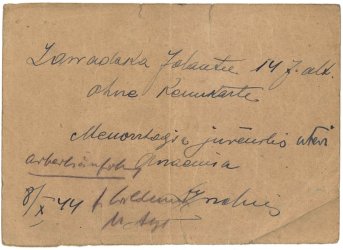
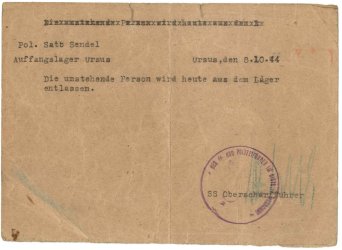
Ursus transfer camp attestation
There was a medical panel in the camp that also included doctors active in the underground movement. They would pick up teenagers from the deported people and give boys and girls medical certificates proving their disastrous status of health which disqualified them from being able to work in forced labor camps. The owners of these certificates were let go of the camp. My friend and I appeared at the medical panel and were given certificates saying that we suffered from typhoid and had to be immediately released from the camp.
I remember it perfectly: at night the large gates opened in front of us, through which railway carriages drove to the camp, and we came outside. We had no idea where we were. I did not know the surroundings of Pruszkow and Ursus. Although my parents had a villa in Komorow, a place not far away from here, I still was not sure how to get there. We set off along the railway tracks. We left Pruszkow and went straight forward in complete darkness.
After some time I realized we reached the perimeter of Komorow. Somehow I found my parents' house. There I met my cousin. Soon the rest of my family, young relatives, that had reached Komorow in various ways, joined us at home. Also my mother finally returned. Thanks to her underground contacts, she managed to get out of the camp in Ursus. I had practically no contact with her during the Uprising. Only once the commander of my unit met the officer in charge of the other squad where my mother served, and informed him that I was alright, after which he received the similar message from my mother.
Other young people from my group met their own destinies. A few of my colleagues were deported to Auschwitz, precisely to the camp of Birkenau. Others were transported from Cracow to nearby transfer camps, from where they were directed to work at households of Polish farmers.
In fall 1945 my father, liberated from Buchenwald by the Americans, arrived in Komorow. The rescued prisoners were in such a bad condition that the Americans decided to keep them for some time on site to let them recuperate and regenerate their health. My father's face was so round and healthy that my mother fainted when she saw him at the door. She could not believe that a prisoner from a concentration camp might look like him and thought he was a kind of apparition. For many months we had not received any message from him and were not sure if he was even alive.
On January 18, 1945, i.e. the next day after the liberation of Warsaw, my friends and I went to visit the city. We moved along the tracks of Warsaw Commuter Railway. Warsaw was still on fire. Heading that way, we reached Zawisza Square. Further on, the street was buried under the rubble.
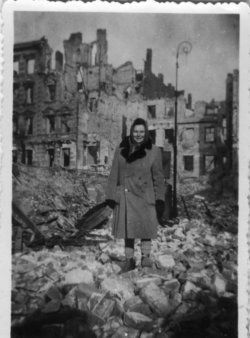
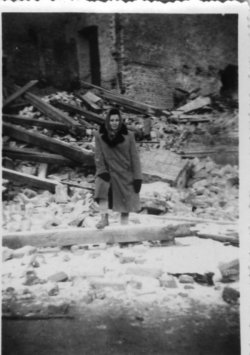
Jolanta Kolczynska among the debris of Swietokrzyska Street at the corner of Wielka Street, 1945
On Aleje Jerozolimskie, all the houses until Starynkiewicza Square were on fire. We headed for Grzybowski Square, picking our way through the heaps of ruins. Everything was turned into rubble - the church and all the buildings razed to the ground.
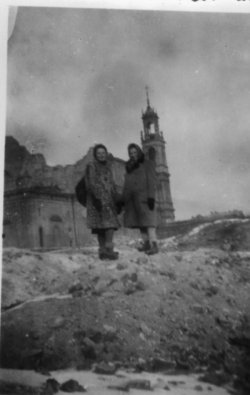
In the background the ruins of St. Savior's Church
The Russians shouted at us: "You cannot go there! Mines! You have to be careful! "But we had to see our district. My friend had a camera and took a few photos. The place looked terrible, one giant mound of rubble.
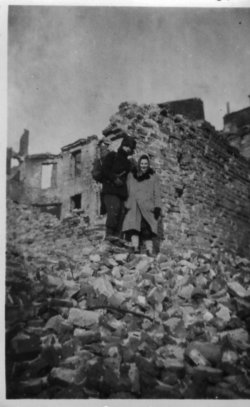
Another picture of Srodmiescie
I was 16 years and 2 months old at that time. At dusk we returned to Komorow.
In the town, the Szachtmajer sisters continued their educational activity. They rented a building and as early as in January 1945 the famous school was reactivated. I pursued my studies interrupted by the outbreak of the Uprising. In 1947 I received a high school graduation diploma. In 1948 the school was closed and the building was taken from its owners by virtue of Bierut's decree. Up to this day there has been a continuous struggle of the Foundation and the former students to regain the property of the Szachtmajer sisters.
In 1947 we left Komorow and settled permanently in Warsaw. My father worked as an economist. We received an apartment in a newly-built building of the National Commercial Center at Unia Lubelska Square.I lived there for 17 years. My home was a nice two-level apartment on the 5th and 6th floor with internal stairs. My mother had her own painter's studio in the apartment. She had graduated from the Academy of Fine Arts in Warsaw in 1939. At that time the Academy was located on Wybrzeze Kosciuszkowskie Street at the corner of Tamka Street.
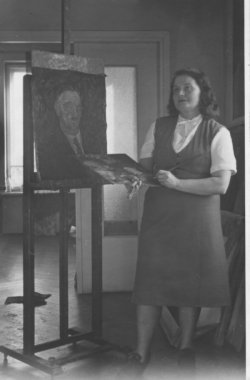
Gabriela Zawadzka near the easels
Just after the Uprising, our youth group came to an agreement that we would not reveal our Uprising activity to anyone. We confirmed our affiliation as late as in the 1970's, when there was a possibility to obtain the combatant status. During the verification process you had to acquire statements from people you had been in direct contact with in "Chrobry II" battalion during the Uprising.
It should be remembered that I was 16 years old during the Uprising. The repressions were mainly directed at adults. My mother was arrested and interrogated on Rakowiecka Street. After this experience she strictly ordered me to destroy my Home Army membership card, which I had saved since the Uprising. This happened in 1947 at the time when we received our apartment. I suggested that I hide my membership card for example under one of the floor boards. My mother firmly objected to this idea: "I do not agree, you have no idea what they can do to you". She was terrified of what she saw on Rakowiecka Street during the interrogations. And so my Home Army membership card was destroyed and did not survive up to these times.
Jolanta Kolczyñska
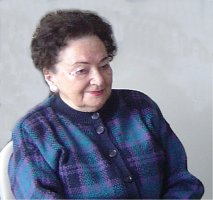
|
Jolanta Zawadzka-Kolczynska née Zawadzka born November 16, 1928 in Warsaw Home Army soldier, messenger, pseudonym "Klara" 6th company of "Jeremi" Home Army group "Chrobry II" |
The author of the memories has received many awards, among them: Army Medal for War 1939-45 (1948 London); Silver Cross of Merit (1975); Medal of Victory and Freedom 1945 (1976); Warsaw Cross of the Uprising (1982); Partisan Cross (1983); Home Army Cross (1984 London); Knight's Cross of the Order of Polonia Restituta (1999). In 2004 Jolanta Kolczynska was awarded the Commander's Cross of the Order of Polonia Restituta.
Jolanta Kolczynska was also awarded two decorations of the French underground movement: Croix Commemorative ZUPRO (1959) and Medaille de Reconnaissance (1979).
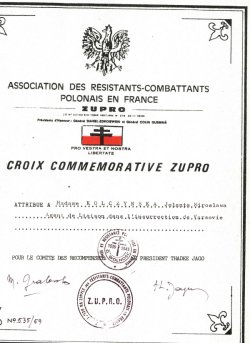
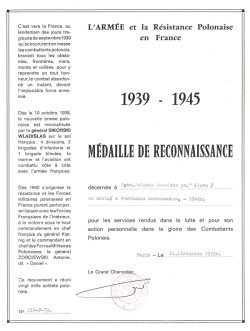
Decorations of the French underground movement
edited by: Maciej Janaszek-Seydlitz
translation: Beata Murzyn
Copyright © 2013 Maciej Janaszek-Seydlitz. All rights reserved.